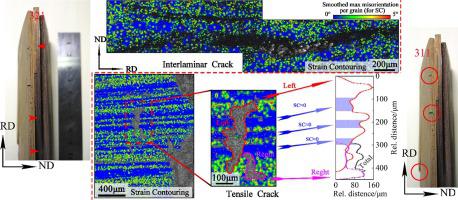Engineering Failure Analysis ( IF 4.4 ) Pub Date : 2021-06-25 , DOI: 10.1016/j.engfailanal.2021.105573
Zhiyang Zhao , Renbo Song , Yongjin Wang , Yingchao Zhang , Chunyang Hu , Yuqi Wang

|
Uncoordinated deformations in non-oriented electrical sheets during cold rolling were investigated for exploring their destruction behaviors. The sheets with interlaminar failures or tensile failures were observed for displaying the influence of matrix factors on crack initiations and growths by using a scanning electron microscope (SEM), equipped with an electron backscattered diffraction (EBSD) detector. The interlaminar failures would grow along the boundaries between deformed layers and undeformed layers, or within seriously deformed layers. According to strain contouring (SC) or local misorientation (LM) maps, the cracks adjoining with dense strain centers or serious local misorientations belonged to plastic failures. And brittle cracks preferred to exist in undeformed layers. In addition, the tensile failures were often located in laminated layers with alternately diverse deformations. The regions adjoining to this kind of tensile cracks were alternately covered by the deformed layers and undeformed layers. All failures above were caused by uncoordinated deformations, showing different intensities of strain centers in each laminated layer. And the uncoordinated deformations could be caused by differences of deformation ability or borne deformation component of each layer. The grains with poor deformation ability and serious deformation component would achieve deformation limits and be broken early, causing crack initiations. And the grain layers with predominant deformation loads would originally attract excessive deformation components and be broken early. Adopting even sheets or high-tension rolling could even the deformation distribution and fill the disadvantage of insufficient deformation ability of some layers for reducing early failures. This investigation would benefit avoiding early failures during cold rolling processes and reducing correlative scrap products and extra energy consumptions. Meanwhile, economic performance and energy conservation would be achieved, also benefitting steel mill factories and long-term environments.
中文翻译:

冷轧不协调变形导致无取向电工板早期层间裂纹和拉伸断裂
研究了冷轧过程中无取向电工板的不协调变形,以探索其破坏行为。使用配备电子背散射衍射 (EBSD) 检测器的扫描电子显微镜 (SEM) 观察具有层间失效或拉伸失效的板材,以显示基体因素对裂纹萌生和扩展的影响。层间破坏将沿着变形层和未变形层之间的边界或在严重变形层内生长。根据应变等高线 (SC) 或局部错误取向 (LM) 地图,与密集应变中心或严重局部错误取向相邻的裂纹属于塑性失效。脆性裂纹优选存在于未变形层中。此外,拉伸破坏通常位于具有交替不同变形的层压层中。与这种拉伸裂纹相邻的区域被变形层和未变形层交替覆盖。上述所有故障都是由不协调的变形引起的,显示每个层压层中应变中心的强度不同。变形不协调可能是由于各层变形能力或承受变形分量的不同造成的。变形能力差、变形成分严重的晶粒会达到变形极限而过早断裂,导致裂纹萌生。而变形载荷占优势的晶粒层原本会吸引过多的变形成分而被提前破坏。采用均匀薄板或高压轧制可以使变形分布均匀,弥补部分层变形能力不足的缺点,减少早期失效。这项调查将有助于避免冷轧过程中的早期故障,并减少相关的废品和额外的能源消耗。同时,将实现经济效益和节能,也有利于钢厂和长期环境。































 京公网安备 11010802027423号
京公网安备 11010802027423号